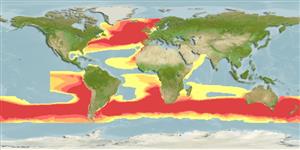>
Myctophiformes (Lanternfishes) >
Myctophidae (Lanternfishes) > Lampanyctinae
Etymology: Lampanyctus: Greek, lampas, -ados = torch + Greek, nykte = night (Ref. 45335).
Environment: milieu / climate zone / depth range / distribution range
Ecología
marino batipelágico; oceanodromo (Ref. 51243); rango de profundidad 40 - 750 m (Ref. 4479). Deep-water; 68°N - 57°S, 180°W - 180°E
Northwest Atlantic: rare west of 50°W between 65°-32°N. Northeast Atlantic: Iceland and British Isles to the Mauritanian Upwelling Region; also in the southern Benguela Upwelling Region (Ref. 4066). Circumglobal in the southern hemisphere in the region of the Subtropical Convergence but with northern extension to about 18°S in eastern boundary currents.
Length at first maturity / Tamaño / Peso / Age
Maturity: Lm 16.9, range 17 - 17.2 cm
Max length : 20.0 cm SL macho / no sexado; (Ref. 5182)
Espinas dorsales (total): 0; Radios blandos dorsales (total): 14-16; Espinas anales 0; Radios blandos anales: 17 - 20
Oceanic, mesopelagic (Ref. 4066), epipelagic to bathypelagic (Ref. 58426). Found between 550-750 m during the day; between 40-550 m at night (juveniles are most abundant in 75 m depth). Feeds on zooplankton (Ref. 58426).
Life cycle and mating behavior
Madurez | Reproducción | Puesta | Huevos | Fecundidad | Larva
Hulley, P.A., 1990. Myctophidae. p. 398-467. In J.C. Quero, J.C. Hureau, C. Karrer, A. Post and L. Saldanha (eds.) Check-list of the fishes of the eastern tropical Atlantic (CLOFETA). JNICT, Lisbon; SEI; Paris; and UNESCO, Paris. Vol. 1. (Ref. 4479)
IUCN Red List Status (Ref. 130435)
Threat to humans
Harmless
Human uses
Más información
Age/SizeCrecimientoLength-weightLength-lengthLength-frequenciesMorfometríaMorfologíaLarvaDinámica larvariaReclutamientoAbundanciaBRUVS
ReferenciasAcuiculturaPerfil de acuiculturaRazasGenéticaElectrophoresesheritabilidadEnfermedadesProcesamientoNutrientsMass conversion
ColaboradoresImágenesStamps, Coins Misc.SonidosCiguateraVelocidadTipo de nataciónSuperficie branquialOtolitosCerebrosVisión
Herramientas
Special reports
Download XML
Fuentes de Internet
Estimates based on models
Preferred temperature (Ref.
123201): 6.8 - 15.4, mean 10.3 °C (based on 418 cells).
Phylogenetic diversity index (Ref.
82804): PD
50 = 0.5000 [Uniqueness, from 0.5 = low to 2.0 = high].
Bayesian length-weight: a=0.00479 (0.00217 - 0.01054), b=3.16 (2.98 - 3.34), in cm total length, based on LWR estimates for this Genus-body shape (Ref.
93245).
Nivel trófico (Ref.
69278): 3.4 ±0.45 se; based on food items.
Resiliencia (Ref.
120179): Medio, población duplicada en un tiempo mínimo de 1.4-4.4 años (Preliminary K or Fecundity.).
Fishing Vulnerability (Ref.
59153): Low vulnerability (14 of 100).
